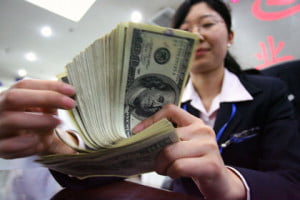Transcribo pequeño estudio efectuado por varios de los principales medios de comunicación económicos sobre el posible destino de las elevedas reservas chinas.

Stories are flying about China’s $3 trillion reserves, with much speculation on how those reserves will be used. First let’s consider the setup.
Bloomberg reports China’s $3 Trillion Reserves Show G-20 Task as Wen Resists Yuan Pressure
China’s foreign-exchange reserves exceeded $3 trillion for the first time, highlighting global imbalances that Group of 20 finance chiefs aim to tackle at meetings in Washington.
China’s currency holdings, the world’s biggest, swelled by $197 billion in the first quarter to $3.04 trillion, the central bank said yesterday. New loans were a more-than-estimated 679.4 billion yuan ($104 billion) in March, it said.
Premier Wen Jiabao’s policy of controlling the currency, along with trade surpluses and flows of capital into the fastest-growing major economy, have boosted the reserves by $1 trillion in two years.
Hot Money Analysis
People’s Daily Online reports China’s forex reserves pass 3 trillion USD for first time
China’s foreign exchange reserves exceeded the mark of 3 trillion U.S. dollars for the first time at the end of March 2011, representing an increase of 24 percent from a year earlier and maintaining its top position around the world, according to data released by the central bank on April 14.
The foreign exchange reserves increased by 197 billion U.S. dollars in the first quarter.
China’s foreign exchange reserves were up by as high as 197 billion U.S. dollars in the first quarter of 2011 from 2.9 trillion U.S. dollars at the end of 2010, with 84 billion U.S. dollars in January, 60 billion U.S. dollars in February and 53 billion U.S. dollars in March.
According to the method released by the State Administration of Foreign Exchange (SAFE) for estimating the amount of «hot money,» the flow of «hot money» is a result of subtracting the trade surplus, a net inflow of foreign direct investments (FDI) and overseas investment returns of the foreign exchange reserves from the increment in the foreign exchange reserves.
China recorded 1 billion U.S. dollars of trade deficit for the first quarter and 18 billion U.S. dollars of FDI for the first two months, the combined amount of which was 180 billion U.S. dollars lower than the 197 billion U.S. dollars of the quarterly increment in the foreign exchange reserves. This marks that the aggregate amount of FDI, overseas investment returns and «hot money» reached 180 billion U.S. dollars in March.
Experts said that given the limited amount of capital inflows, the surge in the foreign exchange reserves in the first quarter was the result of too much «hot money» inflow. The speculation on further RMB appreciation is fueling the «hot money» inflow.
What Does $3,045 Billion Buy?
The Financial Times asks What Does $3,045 Billion Buy These Days?
Italy. Principal and interest on the entire sovereign debt stock of il bel paese, going out to 2062, comes to $3,031bn. Or if China were after commodities, rather than countries, it could stash away 25bn barrels of Brent crude. Based on February’s consumption, that would satisfy almost 13 years of net oil imports. And how about companies? Assuming a civil 30 per cent takeover premium, Beijing could buy up America’s ten biggest listed firms, from ExxonMobil to JPMorgan, or the 15 biggest Euro-stocks, from BHP Billiton to Eni. For true value for money, though, China might want to browse a little closer to home. Its reserves managers could acquire the entire Nikkei 225, with $30bn in change.
Repatriation of Hot Money
That Financial Times speculation sounds nice but it does not work that way. For starters China must keep accumulated hot money reserves to allow for repatriation. Otherwise China would run the risk of a currency crisis.
Second, China already has a problem with soaring commodity costs. It does not need to accumulate more copper, aluminum, iron etc. Indeed China’s infrastructure is massively overbuilt already.
Third, even if China did buy copper and oil (say from from Australia and Iran respectively), what would Australia and Iran do with the dollars? Mathematically, the hot potato (US dollars), will eventually return to the US.
Fourth, China would want to keep several months or more of reserves in excess of reserves held for repatriation of hot money.
Future Shock a Mathematical Necessity
That still leaves a big chunk left, but certainly not the entire $3 trillion.
Here’s what will eventually happen, because it simply must work this way mathematically: With its US dollar reserves, China will buy USA assets, not Japanese equities, not Euro-based assets, not the Italian stock market or Italy’s national debt.
Likewise, with its Euro reserves, China will buy EuroZone assets, not Japanese equities, not US or Canadian assets.
China right now has its US reserves parked in US treasuries. The logical spot for some of those reserves is US corporations and US assets, returning the dollars where they mathematically must return.
Now imagine the shock in Congress were China to make an offer to buy Exxon-Mobile, Boeing, Apple and a basket of technology companies, and every toll-road and bridge in the country. If China wants gold, it could put in a bid for US mining companies.
At some point, such a shock will come. Mathematically it must.
Mike «Mish» Shedlock
http://globaleconomicanalysis.blogspot.com